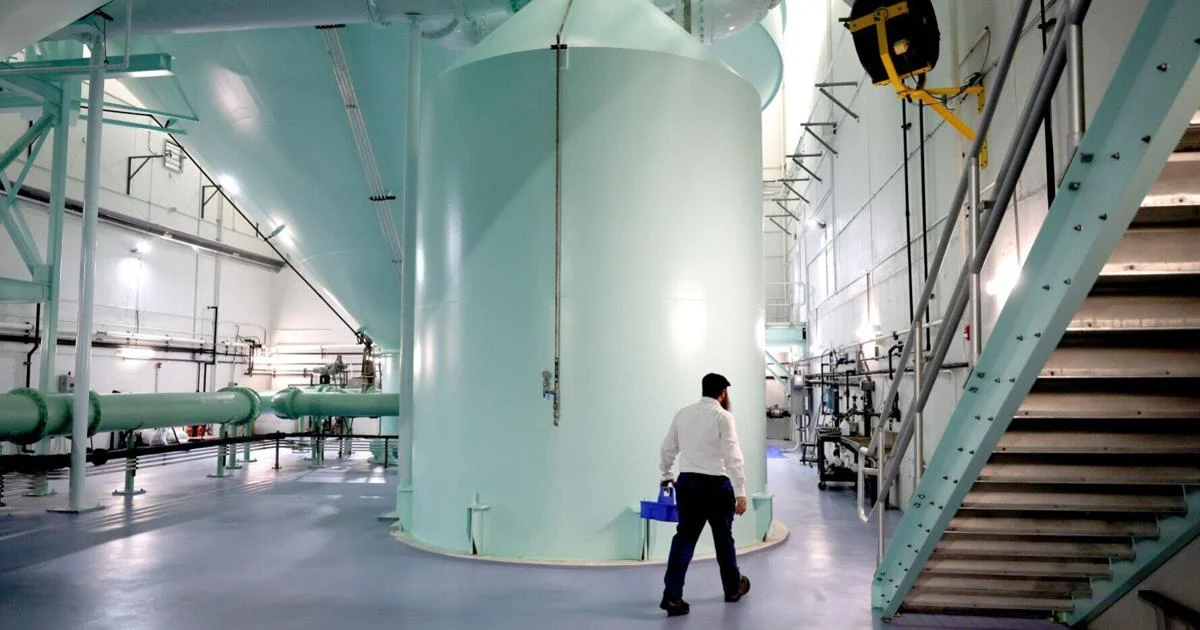
COLLINSVILLE — Collinsville residents and business owners voiced confusion and frustration last week after a recommendation they filter the city’s tap water before drinking or cooking with it because of contamination from the “forever chemicals” known as PFAS.
Word about the contamination, revealed at a City Council meeting on Tuesday, was still getting around late in the week. And plenty of residents were still determining what to do at their homes and workplaces to protect themselves from the group of chemicals linked to serious health issues, including cancer, now in their water.
Even the head of the city’s water plant — who issued the written recommendation shared with the city council last week — said he has not yet figured out which filter to use at home, for his own family.
“I plan to do that this weekend,” said Michael Crawford, working at the plant Thursday.
The city’s PFAS problems are a relatively new — and mysterious — development. Last year, it shut down one of its six wells that draw groundwater from the American Bottoms aquifer, after water from that well showed high PFAS levels. But after its shutdown, PFAS could not be detected in treated water from the other active wells.
That changed when water sampling from May revealed problematic PFAS levels — a finding that a second round of testing confirmed last month. Thousands of different chemicals count as PFAS, which are found in a wide range of manufacturing and industrial processes, and are common in many everyday consumer products.
Many around town grumbled about the predicament they now face — and want financial assistance to help pay for water filters, which residents were already snapping up from local stores.
“We’re probably gonna have to order a bunch more,” said Annabel Gage, a training coordinator working at Cotton’s Ace Hardware of Collinsville.
The city recommends any of three types of water filters to remove PFAS — charcoal filters, reverse osmosis, or anionic exchange point-of-use filters. Some filters cost between about $30 and $80, but need to be replaced regularly, with the frequency influenced by their level of use. And select types of filters on Ace’s shelves cost $130 to $280, while some local residents said at-home installations of certain systems cost around $1,000.
City leaders aim to provide some kind of help to residents, to cover costs. But it’s not yet clear where that funding can come from, as officials scramble to survey options at different levels of government. Filtering will be needed at least until 2029, officials said.
“It’s a big goal and in progress right now,” said Derek Jackson, Collinsville’s city manager.
The city’s water contamination issue — as well as how to proceed with temporary and long-term solutions and how to fund both — is likely to be discussed at the next City Council meeting on Oct. 14, Jackson said.
At the moment, though, some confusion and frustration continue to circulate around town.
Crawford, at the water plant, said he’s been fielding steady calls on the subject, including questions and complaints from residents and local establishments, like restaurants.
But word about the city’s water issue hadn’t spread everywhere, as of Thursday.
Patrick McDill, co-owner of McDill’s Irish Pub, hadn’t heard about the city’s filter recommendation until asked about it by a Post-Dispatch photojournalist, while he was drinking a cup of water. Soon, he had left messages with three plumbers, aiming to figure out a solution for the restaurant.
“I think that (the city) probably should’ve notified the business owners,” he said.
Across the street, where Collinsville Dairy Freeze sells ice cream, owner Theresa Tarrant knew about the warning but said she didn’t have to worry firsthand, because she already has water filters at the shop and at home.
Still, she said, the news about the contaminated water supply is unsettling.
“It’s pretty scary,” she said, imploring the city to take action and help shoulder costs that confront the public. “What are they going to do for us now — for the people that can’t afford to go out and buy filtration systems?”
The Collinsville School District is working with its environmental consulting group, J.S. Held, LLC, “to evaluate potable water in our schools and to develop a system that addresses PFAS,” it said in a statement.
While alternatives like bottled water can make sense in this situation, it is not the savior that some may think, said Crawford. He said health standards for bottled water are looser than those for tap water, and that bottled water “often tests higher in contaminants.”
He also said tap water consistently tastes better than bottled water, in blind taste tests. Collinsville’s tap water has won area taste tests for two years running, while also notching top-five finishes across Illinois, Crawford said.
“In normal circumstances, there’s just no upside to bottled water,” said Crawford.
Collinsville’s existing water treatment system relies on a combination of chemical and physical processes that either make the solids in water “sticky” enough to settle out, get filtered out, or both.
For example, the use of coagulants can make solids stick together enough so that they’re no longer suspended in water, while passing water through granular materials with countless tiny ridges, pockets, snares, cups and hooks can capture additional solids , like “Velcro,” said Crawford.
“These filters are amazing, but the material in them just doesn’t grab PFAS,” he said. “PFAS is so small and so unreactive and so not sticky that neither of those processes catch all of it.”
Crawford said the city doesn’t know where the PFAS contamination is coming from, nor whether it could be from a one-time event that might subside on its own.
Any long-term fix won’t be quick, with 2029 seen as the earliest possible point that systems for removing PFAS could be added to the city’s water plant.
Steps that await include seeking grants and loans, finalizing the design and construction, and conducting a pilot run, before the new equipment could officially begin operation.
One proposal, for instance, would require the addition of eight treatment tanks plus another storage tank, with a significant footprint outside of the current building — equipment that would essentially act as a “large-scale Brita filter,” said Crawford.
Be the first to know
Get local news delivered to your inbox!
* I understand and agree that registration on or use of this site constitutes agreement to its user agreement and privacy policy.
Bryce Gray | Post-Dispatch
Energy and environment
Get email notifications on {{subject}} daily!
Your notification has been saved.
There was a problem saving your notification.
{{description}}
Email notifications are only sent once a day, and only if there are new matching items.
Followed notifications
Please log in to use this feature
Log In
Don’t have an account? Sign Up Today



